
Torso Wound Care Page Menu: 1 2 3 4 5 6 7 8 9 10 Next>>
Torso Wound Care During the Golden Age of Piracy, Page 7
Gunshot Wounds to the Torso
Most surgeons didn't differentiate between gunshot and other wounds to the torso, apparently regarding a wound as a wound, however it was made. There is one exception; military surgeon Richard Wiseman devoted a great deal of energy to discussing gunshot wounds and how they should be handled in his masterwork on wounds. Wiseman specifically devotes a chapter each to the topics of gunshot wounds to the chest and gunshot wounds to the abdomen. Using his material as a basis, we shall as well.
Gunshot Wounds to the Torso - Chest
Wiseman does not begin by giving the surgeon much hope when it comes to gunshot wounds to the chest. "Almost all these Wounds made by Gun-shot are mortal; but it is not consistent with Religion or Humanity, to leave such people
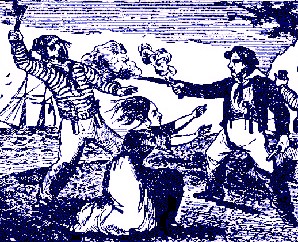
Charles Gibbs Shooting a Comrade, From Pirate's
Own Book
by Charles Ellms (1837)
without help: For sometimes we haply prolong the life of some of them, and now then cure one."1 He later revises this a bit, suggesting the potential for hope, provided the patient wasn't hit in the lungs. "Many Instances may be given of Gun-shot in the Breast: But few do recover that are into the Lungs."2
As he delves into his topic, Wiseman subdivides gunshot wounds to the chest into those which penetrate the thoracic cavity and those which do not. Like other non-penetrating wounds of the chest, he advises that when a gunshot wound "is only in the Musculous flesh, it must be cured as Wounds in the Fleshy parts."3 This suggests that this wound may be treated like any other simple wound, although it would be more appropriate to treat it like any other foreign object wound. (Which is probably what he meant.) Wiseman adds that if such wounds contain a fracture (presumably of the rib), "it must be treated as a Wound with Fracture, taking care to extract the broken Bones, lest they prick the Pleura [membrane covering the lungs], and cause Inflammation."4
He then turns his attention to the method for treating non-lethal penetrating gunshot wounds to the chest. As with most foreign object wounds,
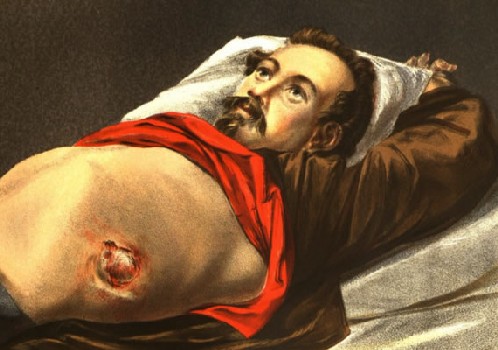
Gunshot Wound to the Thorax, From The Medical and Surgical History of the War of the
Rebellion, 1861-65, by United State Surgeon's General Office (1870)
a primary concern is retrieving foreign materials from the wound. "In the first place, you must make Extraction of the Bullets and other extraneous bodies, Shivers [slivers] of Bones, &c. to give way for the discharge of Bloud and Matter contained in the Cavity of the Thorax [chest]"5. The part about removing foreign objects agrees with the usual treatment of regular gunshot wounds, while the second part about allowing discharge from the wound agrees with the treatment of regular penetrating chest wounds.
Following the lines of normal penetrating chest wound treatments, he recommends that the surgeon "dress the Wound with a Tent dipt in this or such like; Rx. bol. Armen. [Armenian earth] corn. cerv. ust. [burnt hartshorn] ol. ros. [oil of roses] & sambuc. [oil of elder flowers] farin. volatil. [wheat dust], cum ovo integr. [with an egg] Misc. [mixed] Spread a compress with some of the same, and apply it over the Wound."6
If the wound is still bleeding, he advises bloodletting in the arm (presumably with the idea of drawing the blood away from the wound) along with the application and/or injections of astringents, which are medicines used to contract the skin. Wiseman notes that while injection of astringent medicines into puncture wounds is generally not recommended, "in Gun-shot Wounds the Orifice is wide enough for the Injection to return out again"

Photo: Ryan Kildari - Vinca Minor or Lesser Periwinkle
and such medicines not only stop bleeding, but they cleanse the wound.7
The medicine he suggests be used to stop bleeding is:
a Decoction of fol. plantag. ulmi [elm leaves], urticæ [nettles], vincæ pervincæ [lesser periwinkle], ros. rubr. [red rose petals] Fol. myrtill. [myrtle leaves] in aq. germ. querc. [in water of pedunculate oak] Adding a little bol. Armen [Armenian earth] and syr. de symphyt. [syrup of comfrey] Or for present occasion use Red wine, it being excellently good in such bleeding Wounds8
It is interesting that bleeding seems to have been a significant enough problem in bullet wounds to the chest that Wiseman felt the need to dedicate so much space to solving it. Several surgical authors including Wiseman himself note how little these types of wounds normally bled immediately after being received. This suggests a difference between regular bullet wounds and bullet wounds of the chest.
Wiseman goes on to recommend that once the wound has stopped bleeding, short tents are to be inserted with medicine applied to them in order to begin healing the wound from the inside. This is as it is done in other wounds of the chest. The medicine he recommends is:
Rx. terebinth. lot. in decoct. hord. [turpentine in barley water] {2 ounces} pulv. Thuris [powdered frankincense], myrrhæ, [powdered myrrh] {of each 2 scruples} sem. fenugr. Pulv. [powdered fenugreek seeds] {1 dram} ol. hyperici [oil of St. John’s wort] {as much as needed}9
A linen pad with the same medicine applied to it
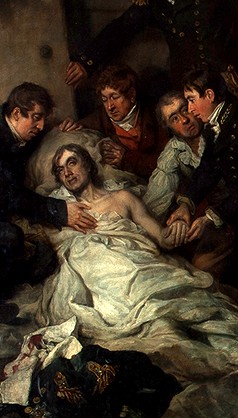
Artist: Arthur William Devis
Chest Bandages, From Death of Lord Nelson (1807)
is used to cover the wound. He then recommends 'digesting' the wound. Digestion of wounds can refer to any or all of the following three things depending on the context: cleansing, healing or encouraging the discharge of 'laudable matter' or pus.10 Wiseman tells the surgeon to use suppuratives, which are medicines that cause the formation of 'laudable pus'. So he appears to be referring specifically to creating and discharging pus. ('Good' pus was believed to be a sign that the wound was ready for healing as explained previously.) He goes on to say that "[a]fter Digestion, you will find it necessary to deterge [cleanse] and incarn [form new flesh]"11, so it can be seen that these are treated as later steps in the healing process rather than part of the 'digestion' of the wound.
Wiseman suggests that during the healing process, the surgeon is to "keep a Cannula in it [the wound] until it cease to run"12. A cannula is a pipe or drain, just like those recommended for use in regular chest wounds. He also tells the surgeon "you must be careful to cut off the Sloughs [dead skin] without, lest from them a stinking Gleet [running fluid] distil upon the Viscera [organs] within [the chest cavity]."13
As with other chest wounds, a variety of procedures to remove unwanted corrupt humors (fluids) are recommended. For example, Wiseman suggests the surgeon "repeat it [bloodletting] as often as you see cause"14. This would keep blood from congregating at the wound site and being corrupted. He also says that enemas are 'required' along with a slender diet and 'pectoral decoctions' or medicines proper to treating chest wounds. He finishes by saying that when there is no fever or any other complications, "Asses and Goats milk may be necessary; yea a Diet of Cows milk alone, or mixed with distilled Milks, and sweetened with Conserve of Roses."15
1 Richard Wiseman, Of Wounds, Severall Chirurgicall Treatises, 1686, p. 434; 2 Wiseman, p. 436; 3,4 Wiseman, p. 434; 5,6,7,8,9 Wiseman, p. 435; 10 John Quincy, Lexicon Physico-Medicum, 1726, p. 127; 11,12,13,14,15 Wiseman, p. 435
Gunshot Wounds to the Torso - Abdomen
Wiseman has less to say about gunshot wounds of the abdomen than he does about gunshot wounds to the chest, just as the other surgeons have less to say about general wounds to the abdomen than they do about general wounds to the chest. He begins by discussing treatment of non-penetrating gunshot wounds to the abdomen, just as he did with gunshot wounds to the chest.
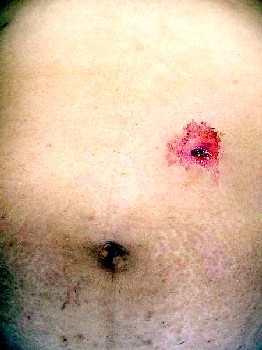
Photo: Bob J. Galindo
Single Gunshot Wound to the Abdomen
Of gunshot wounds to the abdomen he says they "are cured as Gun-shot Wounds in Fleshy parts: In which cases all those Applications are approved of which have been delivered in Simple Gun-shot Wounds."1
He does say that while gunshot wounds not penetrating the abdominal cavity are not usually very dangerous; those "in the Region of the Belly ...are not without peril, especially if [they are in] the middle, where the Linea alba [fibrous structure in the middle of the abdomen] is."2 You may recall that Wiseman raised this same concern for general wounds of the abdomen.
Wounds that do pierce the abdominal cavity are a different matter. He warns that "if they penetrate, there is great hazard, for these Parts so shattered seldom recover."3 The problem with bullet wounds to the abdomen is that
the Bullet is for the most part carried with such force, that it not only wounds the Fleshy parts, but also pierces the Peritonæum [membrane covering the organs], hurting ...the Internals; it being indeed impossible that the Bullet piercing the Parts containing should miss the contained, which are soft and tender.4
Even when patients do survive these wounds, Wiseman says they "are rather Miracles than the work of the Chirurgeon."5 This aside, he proceeds to explain how penetrating gunshot wounds of the abdomen should be treated.
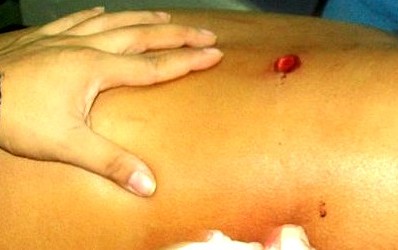
Photo: Bob J. Galindo - Gunshot Wound Through Abdomen
The cure of piercing wounds to the abdomen begin with restoring the omentum or intestines to the abdominal cavity if they have come out. This is the same as is done for all penetrating wounds to the abdomen.
Wiseman then orders the removal of foreign objects - the first step performed in all other bullet wounds. He is particularly concerned about taking out the bullet, "lest it sink into the most inward Parts, and there afflict the Viscera [organs]; as also of the Rags carried in with it, lest they beget Putrefaction [rotting]."6
Although he doesn't specifically discuss this, it is likely that in removing the bullet that the omentum and/or intestines may come back out. So long as they are still healthy and viable, they were likely put back in place after all the foreign objects have been removed from the wound.
As he directed in bullet wounds of the chest, Wiseman addresses the problem of stopping bleeding in this wound, ordering that the surgeon "must inject such Medicaments as have a refrigerant [cooling] and astringent [contracting] quality"7. He says that the medicines used may include:
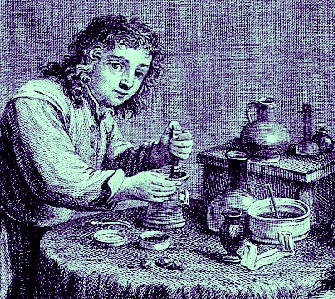
Photo: David Teniers the Younger
Assistant Making Medicines, From A Flemish Surgeon
Treating a Foot, Wellcome Collection (17th. c.)
aq. urtic[arium]. [water of nettles - thought good for curing hemorrhages] plantag. spermat[is]. ranar[um]. [frog spawn water, believed to be cooling] or Red wine, cum syr. de ros. sicc. [with syrup of dried roses, said to be good in stopping flows, particularly in the guts] with pulv. bol. Armen. [powdered Armenian earth] terr. sigill. [powdered sealed earth] sang. dracon. [powdered dragon’s blood resin] Aloes, thuris. [powdered frankincense] Make a Mixture of some of the same Powders with a new-laid Egg, ol. mastic. [essential oil of mastic] & lumbricor. [oil of earthworms]8
This is then to be applied "upon a Tent fastened to a Thread, as is before described, then spread the rest upon a Stupe [piece of absorbent cloth], and lay it over all."9
Once bleeding has been stopped (or if there is no bleeding), the wound is quickly digested - brought to suppurate or form pus - in the same way that bullet wounds to the chest are cured. Medicines used to heal puncturing wounds of the abdominal cavity are the same "as in Simple Gun-shot, and endeavoured by good Fomentations [baths], Embrocations [lotions] and Cataplasms [plasters], to preserve the natural warmth of the Part."10
Wiseman also warns that these wounds have a tendency to turn into tumors. If they do, he says they "require [treatment with] lenient Embrocations, with an empl. é bolo [a plaster of oil, elemental lead, and argillaceous earth] or the like"11.
1 Richard Wiseman, Of Wounds, Severall Chirurgicall Treatises, 1686, p. 431; 2,3,4,5 Wiseman, p. 432; 6,7,8,9,10,11 Wiseman, p. 433;

